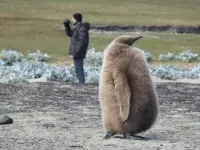Ocean currents predicted on enceladus
Encased in an icy shell, the ocean on Enceladus appears to be churning
2021-03-25
(Press-News.org) Buried beneath 20 kilometers of ice, the subsurface ocean of Enceladus--one of Saturn's moons--appears to be churning with currents akin to those on Earth.
The theory, derived from the shape of Enceladus's ice shell, challenges the current thinking that the moon's global ocean is homogenous, apart from some vertical mixing driven by the warmth of the moon's core.
Enceladus, a tiny frozen ball about 500 kilometers in diameter (about 1/7th the diameter of Earth's moon), is the sixth largest moon of Saturn. Despite its small size, Enceladus attracted the attention of scientists in 2014 when a flyby of the Cassini spacecraft discovered evidence of its large subsurface ocean and sampled water from geyser-like eruptions that occur through fissures in the ice at the south pole. It is one of the few locations in the solar system with liquid water (another is Jupiter's moon Europa), making it a target of interest for astrobiologists searching for signs of life.
The ocean on Enceladus is almost entirely unlike Earth's. Earth's ocean is relatively shallow (an average of 3.6 km deep), covers three-quarters of the planet's surface, is warmer at the top from the sun's rays and colder in the depths near the seafloor, and has currents that are affected by wind; Enceladus, meanwhile, appears to have a globe-spanning and completely subsurface ocean that is at least 30 km deep and is cooled at the top near the ice shell and warmed at the bottom by heat from the moon's core.
Despite their differences, Caltech graduate student Ana Lobo (MS '17) suggests that oceans on Enceladus have currents akin to those on Earth. The work builds on measurements by Cassini as well as the research of Andrew Thompson, professor of environmental science and engineering, who has been studying the way that ice and water interact to drive ocean mixing around Antarctica.
The oceans of Enceladus and Earth share one important characteristic: they are salty. And as shown by findings published in Nature Geoscience on March 25, variations in salinity could serve as drivers of the ocean circulation on Enceladus, much as they do in Earth's Southern Ocean, which surrounds Antarctica.
Lobo and Thompson collaborated on the work with Steven Vance and Saikiran Tharimena of JPL, which Caltech manages for NASA.
Gravitational measurements and heat calculations from Cassini had already revealed that the ice shell is thinner at the poles than at the equator. Regions of thin ice at the poles are likely associated with melting and regions of thick ice at the equator with freezing, Thompson says. This affects the ocean currents because when salty water freezes, it releases the salts and makes the surrounding water heavier, causing it to sink. The opposite happens in regions of melt.
"Knowing the distribution of ice allows us to place constraints on circulation patterns," Lobo explains. An idealized computer model, based on Thompson's studies of Antarctica, suggests that the regions of freezing and melting, identified by the ice structure, would be connected by the ocean currents. This would create a pole-to-equator circulation that influences the distribution of heat and nutrients.
"Understanding which regions of the subsurface ocean might be the most hospitable to life as we know it could one day inform efforts to search for signs of life," Thompson says.
INFORMATION:
The paper is titled "A pole-to-equator ocean overturning circulation on Enceladus." This work was supported by JPL's Strategic Research and Technology Development program; the Icy Worlds node of NASA's Astrobiology Institute; and the David and Lucile Packard Foundation.
ELSE PRESS RELEASES FROM THIS DATE:
2021-03-25
About two decades after first devising a new kind of vaccine, Oregon Health & Science University researchers are unlocking why it stops and ultimately clears the monkey form of HIV, called SIV, in about half of nonhuman primates - and why it's a promising candidate to stop HIV in people.
In scientific papers that were simultaneously published today in the journals Science and Science Immunology, creators of the cytomegalovirus, or CMV, vaccine platform describe the unusual biological mechanisms through which it works.
The findings also helped fine-tune VIR-1111, the CMV-based experimental vaccine against HIV that was developed at OHSU and is now being evaluated in a Phase 1 clinical trial. The trial is being conducted by Vir Biotechnology, which ...
2021-03-25
SILVER SPRING, Md. - As concern has grown over COVID-19 variants and their implications for how well COVID-19 vaccines will protect against the virus, researchers have proposed a method to examine instances of SARS-COV-2 infections in people who have received a COVID-19 vaccine.
Genomic sieve analysis of these so-called "breakthrough" SARS-CoV-2 infections in COVID vaccine trials is a critical tool to identify viral mutations associated with vaccine failure and to predict how vaccination impacts the virus' evolution.
Dr. Morgane Rolland, Chief of Viral Genetics ...
2021-03-25
Scientists at Sinai Health say they have discovered a new pathway that controls dangerous overreactions in a body's immune system, including deadly forms of hyper-inflammation.
In new findings out today in the journal Science, researchers at the Lunenfeld-Tanenbaum Research Institute (LTRI) detail how a protein known as WAVE2, a protein expressed in all immune cells, plays a critical role in maintaining immune system balance.
As part of the research, scientists knocked out, or turned off, WAVE2 in a subset of immune cells in mice, which led to severe autoimmunity and inflammation, ...
2021-03-25
Despite having remarkable utility in treating movement disorders such as Parkinson's disease, deep brain stimulation (DBS) has confounded researchers, with a general lack of understanding of why it works at some frequencies and does not at others. Now a University of Houston biomedical engineer is presenting evidence in Nature Communications Biology that electrical stimulation of the brain at higher frequencies (>100Hz) induces resonating waveforms which can successfully recalibrate dysfunctional circuits causing movement symptoms.
"We investigated the modulations in local ?eld potentials induced by electrical stimulation of the subthalamic nucleus (STN) at therapeutic ...
2021-03-25
Tel-Aviv, ISRAEL - March 25, 2021 - Wild Biotech, a preclinical stage drug discovery & development company emerging out of stealth mode, today announces the publication of its first major paper, which appears in the journal Science. The study mapped the gut microbiota of animals in the wild on an unprecedented scale, adding millions of potentially novel microbiome-based therapeutics for human diseases to the company's already massive database. Wild will use these findings to first tap its database for targets in inflammatory, immune and gastrointestinal diseases.
"For the study, we collected gut microbiota from almost 200 species of animals in the wild, covering diverse classes, feeding behaviors, geographies, and ...
2021-03-25
Water scarcity in rural Alaska is not a new problem, but the situation is getting worse with climate change. Lasting solutions must encourage the use of alternative water supplies like rainwater catchment and grey water recycling. They must also address the affordability of water related to household income, say researchers from McGill University.
Washing hands with clean water is something most people take for granted, yet for Alaska's rural residents, this is often not the case. When people pay for water by the gallon, serious thought is given to how much is used - even during the COVID-19 pandemic.
In many rural Alaskan communities, where jobs are scarce and household income is low, the cost of water is a high burden, according to the study published in Environmental ...
2021-03-25
A medical device that has been shown to manage pain among babies born preterm can also help keep their brain oxygen levels steady during medical procedures, finds new analysis by researchers at UBC.
The device, called Calmer, is a pillow-sized therapeutic bed covered in soft fabric and inserted into the incubator. It can be programmed to mimic a parent's heartbeat and breathing rate-- providing a soothing presence by moving up and down gently to simulate a breathing motion and heartbeat sound for the baby when their parent cannot be present.
"For newborns and particularly for preterm babies, it's critical to keep overall blood oxygen levels steady, especially in the brain. The more stable their brain oxygenation is, the better for their brain development," ...
2021-03-25
Researchers at the Georgia Institute of Technology have uncovered an innovative way to tap into the over-capacity of 5G networks, turning them into "a wireless power grid" for powering Internet of Things (IoT) devices that today need batteries to operate.
The Georgia Tech inventors have developed a flexible Rotman lens-based rectifying antenna (rectenna) system capable, for the first time, of millimeter-wave harvesting in the 28-GHz band. (The Rotman lens is key for beamforming networks and is frequently used in radar surveillance systems to see targets in multiple directions without physically moving the antenna system.)
But to harvest enough power to supply low-power devices at long ranges, large aperture antennas are required. The problem with ...
2021-03-25
Researchers at Baylor College of Medicine, Shandong University in China and other institutions may have found an explanation for dawn phenomenon, an abnormal increase of blood sugar only in the morning, observed in many patients with type 2 diabetes. They report in the journal Nature that mice lacking the circadian clock gene called Rev-erb in the brain show characteristics similar to those of dawn phenomenon.
The researchers then looked at Rev-erb gene expression in patients with type 2 diabetes comparing a group with dawn phenomenon to a group without it and found that the gene's expression followed a different temporal pattern between these two groups. The findings support the idea that an altered daily rhythm of expression of the Rev-erb gene may underlie dawn phenomenon. Future ...
2021-03-25
WASHINGTON (March 25, 2021)--Although demand for COVID-19 vaccines currently seems high, vaccine hesitancy could pose a major threat to public health efforts to end the pandemic, according to an editorial published today in the journal Science.
The authors, including David A. Broniatowski, associate director of the George Washington University Institute for Data, Democracy & Politics, point out that public sentiment towards vaccines are volatile in the face of events such as the recent controversy surrounding the AstraZeneca vaccine clinical trial data. For example, some people could develop safety concerns due to the news reporting about the AstraZeneca vaccine and then turn down the chance to ...
LAST 30 PRESS RELEASES:
[Press-News.org] Ocean currents predicted on enceladus
Encased in an icy shell, the ocean on Enceladus appears to be churning




